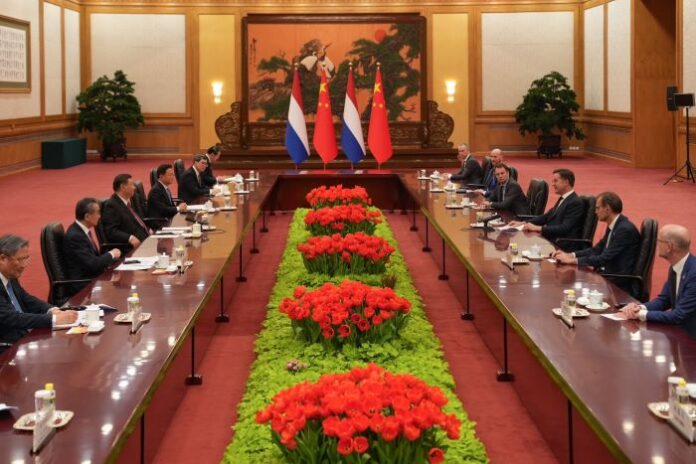China’s leader Xi Jinping has told Dutch Prime Minister Mark Rutte that his government’s efforts to limit China’s access to vital chip-making technology will not halt the country’s technological progress. The two leaders met in Beijing on Wednesday.
Last year, the Netherlands imposed export licensing restrictions on the sale of machinery for making advanced processor chips. This followed a similar move by the US when Washington, citing security concerns, barred China’s access to advanced chips and the equipment to manufacture them.
Without referring directly to the chip issue, an online report by China’s state broadcaster quoted Xi as warning that setting up scientific and technological barriers and disrupting industrial and supply chains would lead to division and confrontation.
“The Chinese people also have the right to legitimate development, and no force can stop the pace of China’s scientific and technological development and progress,” CCTV reported Xi as saying.
The Dutch company ASML is the sole producer of machines that use extreme ultraviolet lithography to make advanced semiconductors. Before the change in export licensing was introduced last year, China accounted for 29% of ASML’s revenues. making it the company’s second-largest market.
PM Rutte told journalists that while ASML does take measures, “we always try to make sure that the impact is limited, is not impacting the supply chain, and therefore is not impacting the overall economic relationship.” As far as the Dutch leader was concerned, the main issue of his meeting with Xi and Chinese Premier Li Qiang was the war in Ukraine. China’s neutral position and the fact that it has lent Russia economic support through trade has upset much of Europe, which sees Russia as the aggressor and Ukraine as the victim.
Rutte said it’s important for China to understand that “this is a direct security threat for us”, noting that should Russia be successful in Ukraine, that would be a threat to the whole of Europe, since it would “not end with Ukraine.”
He added that he had asked China’s leaders to discreetly use “their considerable weight” with Russia “to influence the course of events.”
ASML, the largest company in the Netherlands, recently threatened to leave the country, claiming that anti-immigration policies could hamper its ability to hire talent.
Trade Minister Geoffrey van Leeuwen, who accompanied PM Rutte on his visit to China, told a Dutch business newspaper during the week that although protecting ASML’s interests is a top priority, national security had to take precedence over economic interests.
“I look back on a successful visit to China, which concluded with positive meetings with President Xi Jinping and Premier Li Qiang. As a geopolitical superpower, China plays a crucial role in the world when it comes to economic stability, international security and the transition to a green economy,” PM Rutte posted on X.
“In addition, China is a major trading partner. For all these reasons the Netherlands needs to work with and engage in dialogue with China. There is also scope for frank, substantive discussions to broach concerns, such as the Chinese position vis-à-vis Ukraine. Here in Europe we want China to use its weight to force Putin to end his senseless war of aggression. We also had a candid conversation about our economic relations – about cooperation but also about concerns that China puts up unfair obstacles for European companies that want to do business here. And, of course, we talked about the semiconductor sector, in which the Netherlands and China are both major players. I once again expressed my concern about the human rights situation. For example, the position of Uyghurs and the lack of press freedom. In short, we had an open and honest conversation about not only all that connects us but also about the issues on which we hold very different views. I thank President Xi and Premier Li for the warm welcome today,” Rutte added.

